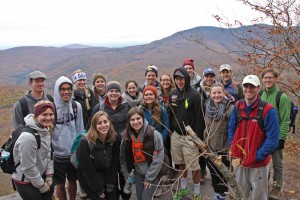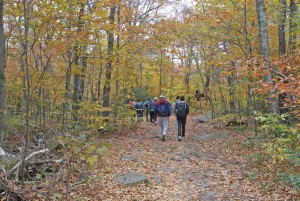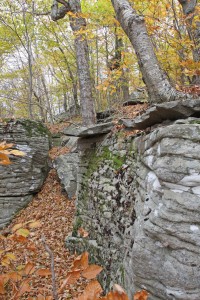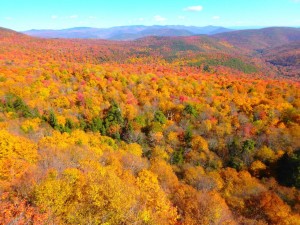Though I am by no means a morning person, I was eager to rise for the trek out to the Catskills last week. My legs were less-than-thrilled to find out they would not fit in front of me, but a few creative sleeping arrangements later, I managed to squeak out a restful 12 or so minute nap on the way there. I have always had an unexplained and probably unnecessary disdain for New York (perhaps my New England sports allegiance extending too far) so I did not have any real expectations for the adventure beyond excitement to be outdoors. Upon arrival my creaky limbs were itching to get moving, and I took to the trail at a near-jog’s pace.
Once I remembered the squats I’d suffered through two days prior, I slowed it down and enjoyed the ascent with the lovely and chipper company of my classmates. Though my usual approach to hiking is kind of a race to the top and a loiterer’s appreciation of the view, I am very easily pleased by nearly every trail I’ve tackled. I was refreshed by the brisk woodsy air, and enamored with the confetti-like scattering of leaves on the ground.
Not long into the hike, we stumbled upon our first dog. I am a BIG dog person, many people liken me to a dog in fact, so naturally, I paused to enjoy the fuzzy hiker. She was a young 4 months old and so eager to take on the trail with her family. The cold air didn’t bother her in the slightest, and she was scaling the rocks like an old pro (despite it being her first hike). Soon after, we encountered a couple and their young daughter and their adult Collie mix. She led the charge, performing impressive switchback maneuvers up ahead before doubling back to be with her humans.
We passed a number of other dogs along the trail, and I was filled with childlike joy each time. They also led me to consider what dogs might think and feel when they accompany their human counterparts in such endeavors. I imagine they must have so excited and pure thoughts about the scents and sights around them. I think I began to aspire to experience the adventure in such a way. I generally don’t think much about my footing and direction while hiking, but I began to take each step even more lightly and precariously, trusting my instinct as a part of nature to guide me safely to the ledges.
Once there, I perched myself as close to the edge as my peers would allow and absorbed the stunning view and all that accompanied it. I was filled with the familiar sense of wonder and satisfaction that follows a successful foray into the forest. I wondered then and I wonder now how the pups might feel in such a moment. Are they aware of their proximity to danger? Are they pleased with their successful ascent? Do they just wish they could find a ball to chase? I hope one day with a dog of my own I can come to understand the pup-like wonder that must come with experiences in the wild.




